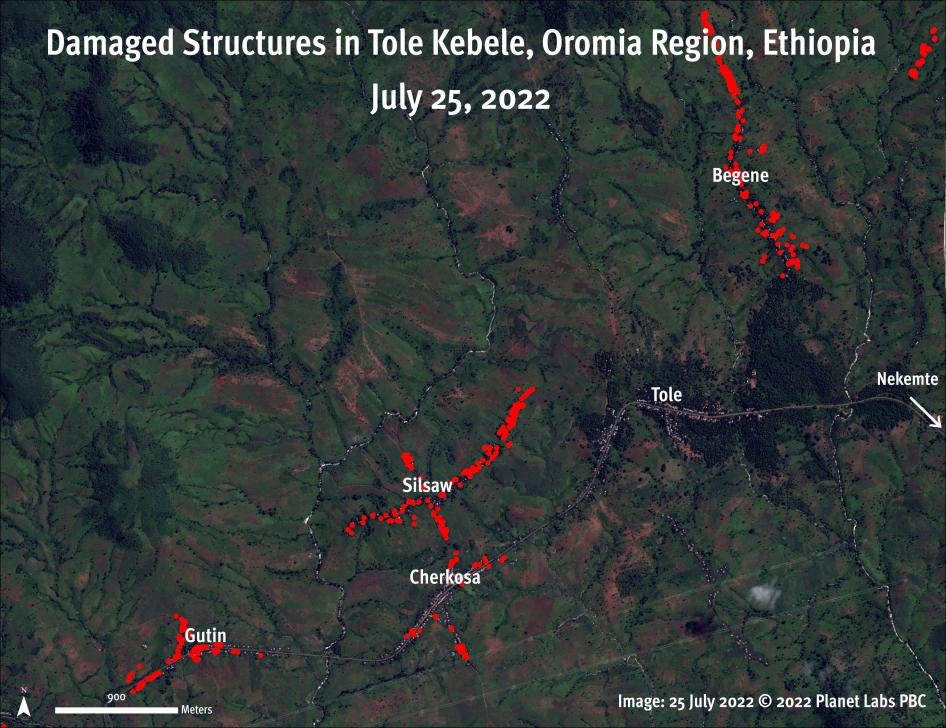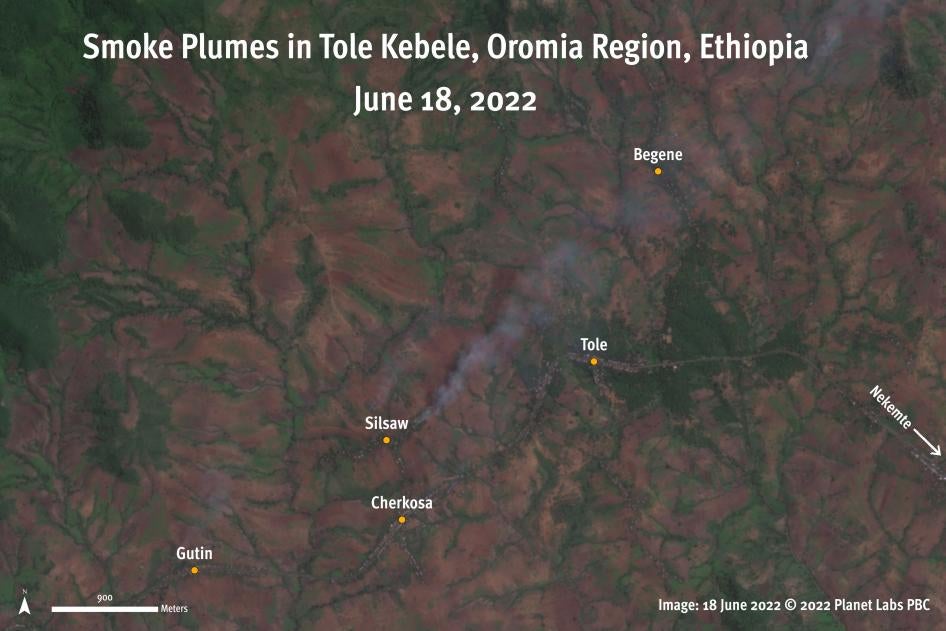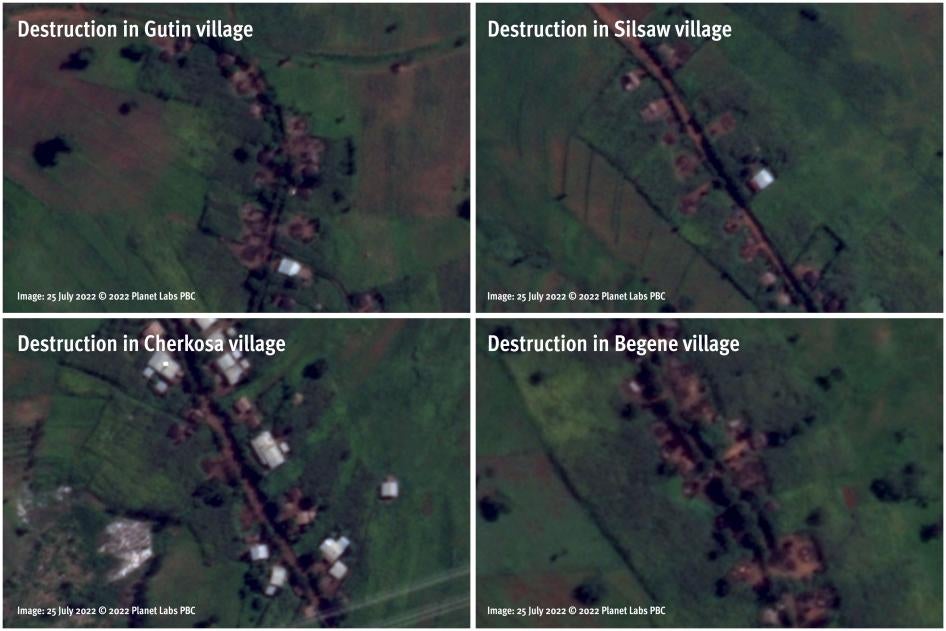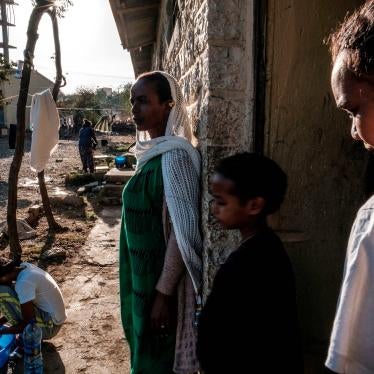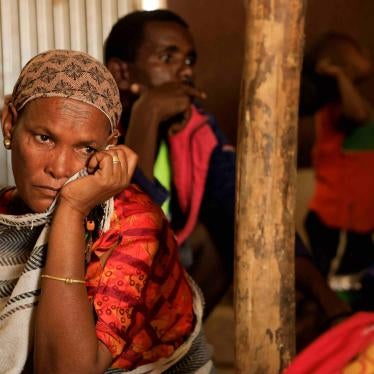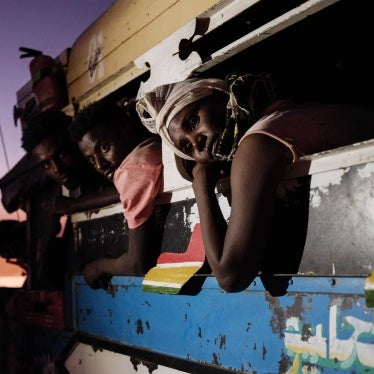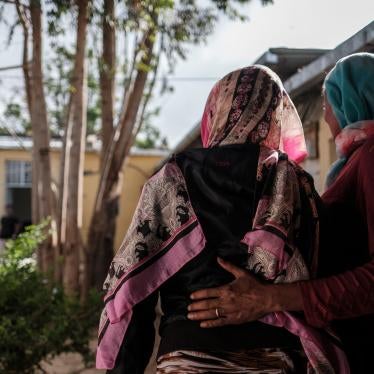(Nairobi, August 31, 2022) – An armed group killed several hundred Amhara civilians in western Oromia in June 2022 while Ethiopian security forces did little to protect them, Human Rights Watch said today. Nearly three months later, the Ethiopian government has failed to provide adequate shelter or meaningfully address the serious health and protection concerns of surviving residents.
For eight hours on June 18, heavily armed assailants shot and killed about 400 Amhara civilians, including many women and children, in villages in Tole and Sene kebeles (wards). The unidentified assailants also burned and destroyed hundreds of homes and businesses, and looted livestock and other property. Satellite imagery analysis corroborated the burning of at least five villages and the destruction of approximately 480 structures. Despite warnings, government security forces stationed nearby did not arrive until hours after the attack.
“Armed attackers destroyed one village after another, killed entire families with unmitigated cruelty, all while nearby government forces appeared to do nothing,” said Laetitia Bader, Horn of Africa director at Human Rights Watch. “This is just the latest such massacre for which the Ethiopian government needs to do more to ensure credible and independent investigations, identify those responsible, and ensure adequate assistance reaches everyone in need.”
Since 2019, government forces and the Oromo Liberation Army (OLA) armed group have been fighting in western Oromia, resulting in serious abuses against Oromo and minority communities. Ethiopian authorities alleged that the OLA was responsible for the June massacre and other attacks. The OLA accused a government militia of carrying out the attacks and called for an independent investigation.
Between June and August, Human Rights Watch interviewed 25 people by phone, including 19 witnesses and relatives of victims from 5 villages: Gutin; Chekorsa; Silsaw; Begene, in Tole kebele in western Oromia; and a village in neighboring Sene kebele in the Benishangul Gumuz region. Human Rights Watch obtained lists of those killed from residents and analyzed satellite imagery collected before and after the attack. From April to May 2021, Human Rights Watch also interviewed 12 witnesses and family members of a similar attack in Bone kebele, in Babo Gembel district in western Oromia, and conducted follow-up interviews in August 2022.
On the morning of June 18, as male residents left to tend to their crops on nearby farmland or to go to the market, leaving woman and children in the villages, groups of heavily armed men unexpectedly attacked villages in Tole and Sene kebeles.
A farmer from Gutin said he first heard gunfire and saw smoke rising from the direction of Silsaw, a village north of the main asphalt road and near Gutin and Chekorsa. “I ran toward my house and noticed the area encircled by gunmen,” he said. “I took my children to the bush for safety and hid in a tree near the village. The gunmen were … fully uniformed and armed … I heard them saying: ‘Finish them. Don’t Leave. End them.’”
A woman from Chekorsa escaped with her five children to nearby maize fields. The attackers pursued them:
My 8-month-old child started crying. I heard an attacker say, ‘Look there, look there …’ before they shot in our direction. They shot my baby dead. I wrapped the dead body with some clothes I was wearing. My other child was shot in her back; the bullet came out around her neck … I then pressed my injured child against my chest, and I prayed to Allah to save her life.
Her older child survived but required two weeks of hospital treatment.
The attacks lasted several hours in some villages, including until 2 p.m. in Gutin and longer in others. Five residents said they made numerous frantic calls to district authorities for help, and to federal and regional government security forces stationed in Jogir, about 17 kilometers from Tole, as well as to a military camp in Didessa. A small contingent of Ethiopian military forces arrived only at 4 p.m., after the attackers had left. Residents then began returning home, where they witnessed the aftermath of the onslaught, and began burying those killed in mass graves.
In Silsaw, residents found bodies throughout the village, including about 29 in the mosque compound. “From a single family, five, six people were killed,” said a 20-year-old woman. “In other cases, families lost 20 people.” In Gutin, residents found 12 charred bodies among the remains of a burned grass house.
Three residents involved in burying victims believed that over 400 people had been killed in at least 6 villages. Community leaders, who gathered lists of those killed and property destruction, estimated that at least 112 were killed in Silsaw, 105 in Chekorsa, 37 in Gutin, 72 in Begene, 16 in Hayaw, and 50 in Sene kebele. At a June 30 media briefing, a spokesperson of the Office of the Prime Minister said that the bodies of 338 people had been identified.
The attacks in Tole and Sene mirror other killings of Amhara civilians in western Oromia. Less than two weeks later, the media reported that armed groups attacked predominantly Amhara civilians in Hawa Gelan district, Kellem Wellega Zone, killing scores. A March 2021 attack on Amhara civilians in Bone kebele, West Wellega Zone, similarly left scores dead.
Survivors from Tole and Sene said that fear of continued attacks in the area, and insufficient protection and humanitarian support was forcing many residents to leave Oromia.
The United Nations Office for the Coordination of Humanitarian Affairs (OCHA) said that at least 4,800 people were displaced from Tole, and that more than 500,000 had been displaced in western Oromia due to the conflict there.
OCHA also reported that it was hard for aid groups to get access to the region because of access restrictions, inadequate funding, and a lack of humanitarian presence. Ethiopian authorities need to create a conducive environment for aid delivery, Human Rights Watch said.
The Ethiopian authorities’ immediate response to the attack was to announce that they would intensify “law enforcement measures” against armed groups. On July 6, Ethiopia’s parliament authorized the establishment of a special committee to investigate violence against civilians in several regions in Ethiopia, including Oromia, and to make recommendations.
But people in Tole, Sene, and Bone kebeles said there have been little signs of investigations so far. The government should provide regular public updates on its investigations, and its steps to curtail abuses by armed groups as well as federal and regional security forces and militias, Human Rights Watch said.
Both the UN High Commissioner for Human Rights Michelle Bachelet and the African Union Chairman Moussa Faki called for independent investigations into the attacks in western Oromia. In a June 30 Oral Update before the UN Human Rights Council, the chairperson of the UN International Commission of Human Rights Experts on Ethiopia expressed alarm at atrocities against civilians in Ethiopia, including western Oromia, and urged member states to provide the commission with experienced investigators and other support.
“Communities in western Oromia have been left reeling from repeated attacks and are living in fear of the next attack,” Bader said. “Ethiopian authorities should urgently move beyond promises to act and provide urgent and adequate humanitarian assistance to affected communities, and support for credible independent investigations.”
Conflict in Western Oromia
Since 2019, Ethiopian government forces and the Oromo Liberation Army (OLA) armed group have engaged in an armed conflict in western Oromia. The OLA was previously the military wing of the Oromo Liberation Front (OLF), a once-banned political opposition group, that fought a low-level insurgency for the self-determination of Oromos for decades.
After Prime Minister Abiy Ahmed assumed office in April 2018, the government reached an agreement with various opposition groups, including the exiled leaders of the Oromo Liberation Front in Eritrea, who agreed to lay down arms, reintegrate, and commit to a peaceful political struggle. However, negotiations soon broke down.
By early 2019, the government had established military command posts in western and southern Oromia. Federal and regional security forces began coordinated military operations against the OLA. In April 2019, the OLA formally broke its ties with the OLF and continued its armed operations.
The conflict has resulted in serious human rights abuses. Government forces have carried out summary executions, arbitrary arrests, and detentions of Oromos, and have at times cut communications in the area. The OLA has killed government officials and attacked non-military government offices. Unidentified armed assailants have also been implicated in killings, abductions, destruction of homes, and mass displacements of ethnic Amhara communities. Residents of Tole kebele in western Oromia said that OLA fighters in the neighboring hills for the past three years have abducted people and demanded ransom.
Human Rights Watch documented a March 30, 2021, attack on Babo Gembel district, West Wellega Zone. At around 8 p.m., gunmen surrounded Sedeka village, in Bone kebele, forced the Amhara residents to gather for a meeting, and shot 28 dead. A man who had fled the village as residents were being gathered said that the armed men spoke Afaan-Oromo, the Oromo language, and had distinctive long hair, which residents said was common among OLA fighters. He climbed a tree and stayed there until 2 a.m., “I later heard gunfire,” he said at the time. Residents called for help from the Oromia regional special forces, who were stationed about 30 minutes away, but they didn’t arrive until 2 a.m., long after the attack had ended.
One village leader lost his brother and his sister-in-law in the attack. “We had just celebrated their marriage on Thursday [March 25], and they were then killed on Tuesday evening,” he said. “After all the preparations to celebrate their marriage, we began to prepare for their funeral … A mother of a 15-day-old baby was also among the killed.”
Attacks in Tole and Sene Kebeles, June 18
On June 14, the OLA clashed with government forces in the Gambella region, and in Gimbi town, in western Oromia, 49 kilometers from Tole kebele. Around June 17, government security forces stationed in Tole, along with a small number of local militiamen and Oromia police, left the area without explanation, several local residents said.
In the early hours of June 18, residents in several villages in the adjacent Tole and Sene kebeles saw armed men gathering. They said the attackers wore a mix of civilian clothes and uniforms worn by the Oromia regional special forces, militias, and the former Ethiopian national military uniform. They later noted that they spoke in Afaan Oromo and some of the armed men had long hair.
At 7 a.m., a farmer in Silsaw village and a kebele official, among others, called various officials and security forces for protection and support. The official said, “When I first called, they said they couldn’t take action, without discussion and reaching an agreement with the zone [an administrative division].”
Around 9 a.m., attackers began shooting near Silsaw village in Tole kebele andstarted torching village buildings. Residents said scores of men, armed with military assault weapons, then stormed villages around Tole and Sene kebeles and pursued residents who fled into surrounding areas.
Some farmers around Silsaw and other villages reported that they initially tried to resist the attack, but were outnumbered by the armed men, who carried machine guns, rifles, and Kalashnikov assault weapons. “Some of the men among us had our own guns,” said a farmer from Silsaw. “When they started shooting, we also tried to defend ourselves. Twelve people among us who were trying to defend themselves were also killed.”
Many residents began to flee into nearby farmland or river areas. An 18-year-old woman from Silsaw village described being captured:
I was fetching water when these forces approached. I ran to Chekorsa village, but I was caught and taken away from there to a field. Others that were running away were shot. They gathered other people as well [and brought them to the field]. Many were children. We were around 60. They asked us for money, phones, jewelry, and watches. After they took our property, they started shooting.
They were bragging, as they were shooting … saying “We are heroes, and no one can escape from us. We will kill you all. Even those who escape, we will come after you wherever you are.”
The woman said she was shot in the arm, around her back, and in her leg, but managed to survive, along with seven other people.
A man, 48, said: “We hid in the bushes. Two people were killed near me. One was my wife’s relative. He left behind three young children.”
A woman, 20, fled Silsaw village along with her aunt and her aunt’s 6-month-old twins. “I was carrying one of the babies … It was such a difficult moment,” she said. “Bullets were going over our heads. I thought we were doomed. We survived by God’s mercy.”
Retrieval of Bodies, Burials
At about 4 p.m., a small contingent of Ethiopian military forces arrived in Tole kebele. Residents began returning home that evening.
A farmer, 48, from Gutin lost four family members, including his 22-year-old in daughter-in-law and his 4-year-old granddaughter. He found their charred bodies along with 10 other people, in a burned grass-thatched house in the village. He said that 5 of those killed were children under age 8.
In Sene kebele, a man from Sene village returned to find 21 people in his compound dead, including his wife and daughter, 8 other relatives, and several neighbors. His 11-year-old son survived but had been shot 4 times.
A man from Chekorsa said he had desperately searched for his family:
I tried to go check on the house where I took my family members [for safety], but they weren’t there. I looked for them in the maize fields but couldn’t find them. I heard that many people were collected and killed in Silsaw [a neighboring village]. I saw people injured and dead on the way.
He said he found the bodies of his wife, who was 8-months’ pregnant, and their three young children in the mosque compound, where the assailants had gathered and executed 29 people:
My wife and three children, ages 2, 6 and 10, were killed with others in the compound of the mosque. Everyone was rushing to identify the dead bodies. I tried to help gather those killed. It was raining heavily at the time.
It’s difficult to explain what I felt after what happened. I can’t say that human beings did this. It is the maximum cruelty I have seen. We couldn’t bury them all that day.
Residents said that 112 people were killed in Silsaw alone and that they buried about 60 people in the mosque compound. Community leaders said that over 400 people were killed in Tole and Sene areas, during the June 18 attack, and had made lists of the dead.
“The majority of the victims were women and children,” a kebele official from Gutin village said. “The village was filled with dead bodies … We started collecting them and burying them in different areas, some in mass graves.”
Some of the survivors had been displaced from other areas. “We previously lived in Arjo [East Wellega Zone],” said a 38-year-old woman from Tole. “We were forced to leave the area after our houses were burned and property looted. That was eight months ago, and we fled to Tole, now [this] happened again.”
Looting and Destruction of Property
The assailants looted property and livestock and destroyed civilian structures during the attack. Satellite imagery recorded on June 18, at about 10 a.m., shows smoke plumes emanating from Gutin, Chekorsa, and Silsaw villages. Additional smoke plumes were visible over Gutin 45 minutes later. Thermal anomaly data collected by an environmental sensor, and reviewed by Human Rights Watch, also confirms the time of those attacks, showing several fires in Tole kebele.
Human Rights Watch was able to estimate the scale of the destruction by analyzing satellite imagery recorded on July 25. Damage signatures detected on satellite imagery are consistent with arson and confirm the destruction of approximately 480 structures across 5 villages in Tole kebele, including Gutin, Chekorsa, Silsaw and Begene, but were unable to identify the fifth village with visible destruction. Most of the damaged structures seen on imagery are tukuls (huts). Silsaw and Begene recorded the highest number of structures affected. These numbers might be an underestimate, as it only included the area covered by the satellite imagery.
A man from Chekorsa said that his house had bullet holes and several other houses in the village were burned, and stores destroyed.
“I had so many properties back there,” said a man from Silsaw. “I had a farm, I just brought fertilizer. But my house was burned down, I lost everything.” He had left Silsaw for Wollo, in the Amhara region and had no plans to return.
Three residents from Silsaw and Begene villages said that a separate group of attackers had looted property, including livestock and personal items. A resident of Begene said:
There were three groups. The first that killed people indiscriminately, a second group that looted cows and properties, and a third that burned houses. Sixteen of my cows were taken, and 100 quintals [a unit of weight equal to 112 pounds] of grain destroyed. My house was burned down, and I lost over 200,000 Ethiopian birr [US$3,800].
Inadequate Investigations and Humanitarian Assistance
The government and the Ethiopian Red Cross reported that they provided humanitarian assistance to residents following the June 18 attack. However, remaining residents who spoke to Human Rights Watch said that they only received a one-time distribution of food, and as of August lacked shelter and faced serious health risks.
A farmer, 48, from Silsaw said: “We are now living with the help of the Ethiopian military who are sharing their own food … We don’t even have enough cooking utensils, so we are sharing one utensil among 10 people.” A man from Chekorsa said a registration of remaining residents took place in early August but added that they still did not receive any additional aid.
A farmer from Begene said: “There is nowhere to shelter now. It’s the rainy season. We sometimes use plastic shelter from the rain. But we don’t have enough food to sustain our lives ... we are worried about malaria.” He added: “It’s time to remove the weeds from the farms, but we can’t because it’s not safe. The Ethiopian military can’t protect us there so people are losing hope to live here and are leaving … Many went to Wollo or Debre Birhan [in the Amhara region].”
Survivors with serious injuries have also faced obstacles to receiving adequate medical care. The man from Sene whose 11-year-old son was shot four times said he had been struggling to get him proper treatment: “I am begging to treat my son and moving from hospital to hospital … My son is not completely healed, but the hospital gave me a discharge letter. And I don’t know where to take him now. I am standing in the rain. I don’t know where to go. Right now, I have nothing.”
Similarly, more than 18 months after the March 2021 attack on Bone kebele, the survivors were still living at a displacement site in Benishangul-Gumuz. “It’s been four months since we received food aid, we are starving,” said the village leader in August. “We received a call from the local authorities to return, but still, we are afraid. We were informed that it is still insecure …We heard that only four people were punished, and that many residents seeking to flee have been abducted.”
Several residents from Tole raised concerns that the government had inadequately investigated the attack. “One week after the incident, a wereda (district) official and the vice-president of the Oromia regional state came and talked to us,” said a man from Gutin. “Since then, no one has talked to us.” A farmer from Begene said that “no government body came to my village to investigate the number of killings or property destroyed.”
However, a farmer from Silsaw said that government investigators came once to speak to communities gathered around Chekorsa village: “They went around Chekorsa and Silsaw. They went to Silsaw to observe where people were buried, and property destroyed. But they didn’t go to other areas where the attacks happened.”
Recommendations
All parties to the armed conflict in western Oromia should facilitate the provision of humanitarian assistance to all populations at risk. They should also cooperate and provide full, unimpeded access to independent investigators to all conflict-affected areas.
The Ethiopian government should:
- Publicly provide information on the steps it is taking to investigate and appropriately prosecute killings, pillage, the destruction of property, and other abuses by non-state armed groups.
- Urgently provide or facilitate humanitarian assistance, including food, medical care, and shelter to Amhara and other communities affected by June 18 violence and other incidents of violence in Oromia.
- Investigate the role of local and regional authorities and national security forces who may have been negligent in their duty to protect civilians, and publicly disclose the results of the investigation.
- Ensure credible, independent, and impartial investigations into reports of security force abuses, including arbitrary arrests and extrajudicial executions of Oromo communities in western Oromia.
To the OLA and other armed groups operating in western Oromia:
- Immediately end all unlawful attacks on civilians and civilian property.
- Appropriately punish commanders responsible for unlawful attacks and other abuses.
